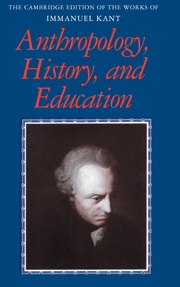Book contents
- Frontmatter
- Contents
- General editors' preface
- Preface
- General introduction
- 1 Observations on the feeling of the beautiful and sublime (1764)
- 2 Essay on the maladies of the head (1764)
- 3 Review of Moscati's work Of the corporeal essential differences between the structure of animals and humans (1771)
- 4 Of the different races of human beings (1775)
- 5 Essays regarding the Philanthropinum (1776/1777)
- 6 A note to physicians (1782)
- 7 Idea for a universal history with a cosmopolitan aim (1784)
- 8 Review of J. G. Herder's Ideas for the philosophy of the history of humanity. Parts 1 and 2 (1785)
- 9 Determination of the concept of a human race (1785)
- 10 Conjectural beginning of human history (1786)
- 11 Some remarks on Ludwig Heinrich Jakob's Examination of Mendelssohn's Morning hours (1786)
- 12 On the philosophers' medicine of the body (1786)
- 13 On the use of teleological principles in philosophy (1788)
- 14 From Soemmerring's On the organ of the soul (1796)
- 15 Anthropology from a pragmatic point of view (1798)
- 16 Postscript to Christian Gottlieb Mielcke's Lithuanian–German and German–Lithuanian dictionary (1800)
- 17 Lectures on pedagogy (1803)
- Editorial notes
- Glossary
- Bibliography
- Index
14 - From Soemmerring's On the organ of the soul (1796)
Published online by Cambridge University Press: 05 May 2013
- Frontmatter
- Contents
- General editors' preface
- Preface
- General introduction
- 1 Observations on the feeling of the beautiful and sublime (1764)
- 2 Essay on the maladies of the head (1764)
- 3 Review of Moscati's work Of the corporeal essential differences between the structure of animals and humans (1771)
- 4 Of the different races of human beings (1775)
- 5 Essays regarding the Philanthropinum (1776/1777)
- 6 A note to physicians (1782)
- 7 Idea for a universal history with a cosmopolitan aim (1784)
- 8 Review of J. G. Herder's Ideas for the philosophy of the history of humanity. Parts 1 and 2 (1785)
- 9 Determination of the concept of a human race (1785)
- 10 Conjectural beginning of human history (1786)
- 11 Some remarks on Ludwig Heinrich Jakob's Examination of Mendelssohn's Morning hours (1786)
- 12 On the philosophers' medicine of the body (1786)
- 13 On the use of teleological principles in philosophy (1788)
- 14 From Soemmerring's On the organ of the soul (1796)
- 15 Anthropology from a pragmatic point of view (1798)
- 16 Postscript to Christian Gottlieb Mielcke's Lithuanian–German and German–Lithuanian dictionary (1800)
- 17 Lectures on pedagogy (1803)
- Editorial notes
- Glossary
- Bibliography
- Index
Summary
EDITOR'S INTRODUCTION
In 1796 the physician and anatomist, Samuel Thomas Soemmerring (1755–1830) published an eighty-page treatise entitled Über das Organ der Seele (On the Organ of the Soul), in the first part of which he described the anatomy of the human brain by detailing the path of the nerves from the various regions of the body to their endings in the brain's ventricles and the liquid they contain. He discussed the role of the ventricular liquid in terms of the traditional psycho-physiological concept of the sensorium commune (common sensory organ), in which the different sensory data converge and combine. In the second part of the work Soemmerring went on to speculate about the vital properties of the ventricular liquid and its function as the “seat” (Sitz) or “organ” (Organ) of the soul, thereby pursuing the specific localization of psychic entities in the anatomy of the human brain.
Prior to publication Soemmerring had sent the completed manuscript of his work to Kant, indicating his intention to dedicate the work to Kant. Kant responded with a letter to Soemmerring dated 10 August 1795 that contained his thanks for the planned dedication and included as an insert a detailed statement on Soemmerring's work, to be used as Soemmerring saw fit. Soemmerring thanked Kant for the statement and the permission in a letter dated 22 August 1795, in which he also stressed his caution in using the terms “seat of the soul” and “common sensory organ” and greeted with enthusiasm Kant's speculations on the organizational properties of liquids, specifically of the “brain water” (Hirnwasser).
- Type
- Chapter
- Information
- Anthropology, History, and Education , pp. 219 - 226Publisher: Cambridge University PressPrint publication year: 2007



